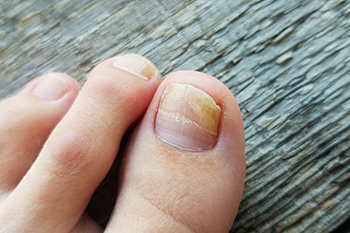A toenail infection, also known as onychomycosis, is a common type of nail disease caused by various types of fungi. Older adults and those with diseases that compromise the strength and quality of nails—such as diabetes, circulatory conditions, and immune suppression disorders—are more at risk of contracting a toenail infection. Other risk factors include genetics, having overly sweaty feet, and going barefoot in public showers, locker rooms, swimming pools and other dark, damp places where the fungi thrive. Among the symptoms of a toenail infection are thickened and discolored nails, pain, the nail separating from the nail bed, and a foul odor. It is wise to consult a podiatrist for toenail infections because they are difficult to treat, as well as to prevent the infection from spreading to other nails and skin. To make an accurate diagnosis and determine the best form of treatment, your podiatrist will perform a physical examination and take a sample of the nail to be cultured and analyzed. Depending on their findings, treatments may include prescription oral and/or topical antifungal medications, nail debridement or even laser therapy.
If left untreated, toenail fungus may spread to other toenails, skin, or even fingernails. If you suspect you have toenail fungus it is important to seek treatment right away. For more information about treatment, contact one of our podiatrists of Foot and Ankle Center. Our doctors can provide the care you need to keep you pain-free and on your feet.
Symptoms
- Warped or oddly shaped nails
- Yellowish nails
- Loose/separated nail
- Buildup of bits and pieces of nail fragments under the nail
- Brittle, broken, thickened nail
Treatment
If self-care strategies and over-the-counter medications does not help your fungus, your podiatrist may give you a prescription drug instead. Even if you find relief from your toenail fungus symptoms, you may experience a repeat infection in the future.
Prevention
In order to prevent getting toenail fungus in the future, you should always make sure to wash your feet with soap and water. After washing, it is important to dry your feet thoroughly especially in between the toes. When trimming your toenails, be sure to trim straight across instead of in a rounded shape. It is crucial not to cover up discolored nails with nail polish because that will prevent your nail from being able to “breathe”.
In some cases, surgical procedure may be needed to remove the toenail fungus. Consult with your podiatrist about the best treatment options for your case of toenail fungus.
If you have any questions, please feel free to contact our office located in Egg Harbor Township, NJ . We offer the newest diagnostic and treatment technologies for all your foot care needs.

